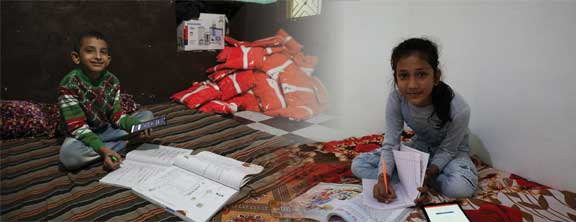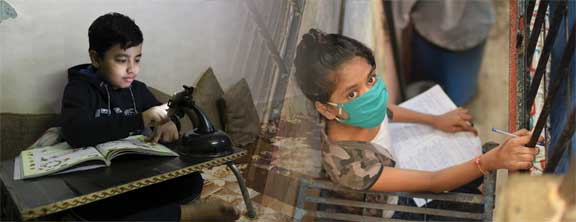Exploring lived experiences of children from low-income families
Vignesh Krishnan
Asma is a student in a government high school in Hyderabad. The prolonged school closure coupled with online classes has made learning an arduous task for her. Asma uses a single device, which she shares with her three sisters, to attend online classes. Between them, Asma gets to use the device for roughly two hours a day. Further, the limitations of the internet connection hampers her from fully engaging in the online classes.
Asma’s story is not an exception. Mahesh is a student in a budget private school in Hyderabad. Like Asma, Mahesh too faced an ocean of challenges when migrating to online learning. To begin with, Mahesh and his siblings had to now rely on their mother’s phone to attend online classes. For Mahesh, balancing his online classes with those of his siblings meant he had very little access to the device. Mahesh’s mother speaks of feeling stressed due to the compounding costs of education, from school fees to online recharges, especially in the backdrop of a pandemic that has posed deepened socio-economic insecurities.

Asma and Mahesh are among the millions of students in India facing similar problems in attending online classes. School closures necessitated by the Covid-19 pandemic have impacted over 1.5 billion children around the world, potentially widening the learning gap (David et al, 2020). In India, a recent study found that 92 per cent of students in government schools lost at least one language ability, and 82 per cent have lost one mathematical ability, compared to the pre-pandemic time. These include basic arithmetic operations, describing 2D shapes, reading familiar words and writing simple sentences based on a picture (APU, 2021).
Given that a majority (60 per cent) of students in India are enrolled in government schools (FICCI, 2014), issues such as lack of devices, unstable electricity, highly-priced mobile internet packages compounded by the health and economic insecurity owing to Covid-19 do not even begin to capture the plight faced by most students in the public education system in the country. A report by the Azim Premji University is most emblematic of this plight, reporting that less than 1 in 4 students have access to more than one smartphone. In cases where parents take a phone to work, students are left with no means of accessing online classes. Similarly, 70 per cent of parents believed online learning was not suitable for their children (APU, 2020).
This article aims to distill lessons learned from a study commissioned by Teach For India (TFI), in the wake of the lockdowns necessitated by the pandemic. The goal of this study was to understand the experience of children from low-income communities when learning at home, along with those of their parents.
When the pandemic hit, TFI designed an extensive online Blended learning programme, “to facilitate instruction for more than 32,000 children” (Rai, 2020). TFI’s work with children from lower socio-economic backgrounds in government and budget private schools led the organization to begin reaching out to children and parents, tracking their well-being during the pandemic and undertaking relief campaigns for the distribution of ration. It was during this period that we sought to study how children in urban low-income communities in Hyderabad experience blended learning.
The study was largely qualitative in nature and employed a three-step methodology. This included surveys, semi-structured interviews and virtual classroom observations. About 150 students from five different schools were chosen for the study, along with 28 parents and 14 Teach For India educators. The primary purpose of the study was to give voice to children and parents, a hitherto neglected group in most research. While studies led by Aristovnik et al (2020) and McAleavy et al (2020) rightly focus on the practical problems facing children from low-income countries/communities, through a macro-level global view, our study captures the lived experiences of children from low-income families in India.

Challenges of online learning
One of the most pressing challenges for children was the availability of and access to a device. Over 50 per cent of children that we interviewed shared devices with their family members. In some cases, where children self-reported unrestricted access, they still had to share their device for some part of the day. This is particularly important for learning from home because learning is mediated through the device. This is also a reason for children preferring school over online learning. As one student said:
“In school, we can spend all day there. But in (sic) phone, we cannot spend so much time because it will cause health issues. And in school we can talk to each other, but in phones we have network problems… Sometimes when me and my sister use the phone the net will be paused, and if I don’t attend online class today, tomorrow’s class will be hard for us.”
The student here points to the cumulative nature of learning. Falling behind on one day of learning translates to added work for the next day.
Another structural issue for children was the physical discomfort they faced when attending online classes. At least 27 per cent of the children mentioned eye problems, 14 per cent spoke of headaches, 7 per cent back pain, 4 per cent neck pain/ear problems as significant issues that prevented them from taking full advantage of tech-based learning. A class 9 student explains it better:
“I have headaches everyday…. In school we used to have open air and study in the classroom, in online classes we have to sit in front of phone and I get eye pain also. Sometimes I get very bored and so I do not complete my homework – I would like to go to school again so I will not face any headaches and other problems.”
The student here ties her preference for school to the discomfort facing her due to the nature of online classes. More interestingly, she states her boredom in homework completion, a common theme in our study. It is difficult to overstate the importance of a physical environment that is conducive to learning, particularly at a time when children are learning online. While tables and chairs are the norm in terms of the immediate learning space, our observations pointed to children sitting on the floor or a mattress.
Along with the home environment, another structural challenge has been the gendered nature of learning. We found that girls were disproportionately impacted by housework, and this impeded their ability to learn. At least five such children reported having missed classes because of the amount of housework they had to undertake. Likewise, for about 40 per cent of girls that were interviewed, housework contributed to an increased workload, while the figure for boys was less than 8 per cent.
There are two important comparison factors here. One is the difference between siblings, and the other is parental perception of gender. We had the opportunity to speak to three such pairs of siblings during the course of the interviews. A clear gendered division in housework appeared in all such accounts. For instance:
Saiema (Grade 8): “I have a lot of work at home. I have to sweep, wash utensils, help my mother and be by her side. So sometimes if the homework is more, then my mother has to do the work all alone. So helping her, completing homework and attending classes also – it becomes a lot, my work increases.”
Irfan (Grade 8): “I wake up at 12 p.m., 12 or 1 p.m… It (work) didn’t increase, it actually became less.”
Some parental accounts also reflected this bias: “Yes it’s a good thing – she’s a girl after all; even if she becomes a doctor ultimately she has to go to the kitchen, so in that way I think it’s good that she is doing housework.” – Ameena (Parent)
In both student and parent accounts, a rather blunt association of girl children with housework emerges centrally, which stems from a deeply patriarchal understanding of women’s roles within the household. Parental perceptions of children, particularly girl children, roles at home, and their understanding of the prevailing online learning model then becomes an important factor dictating the learning environment at home.

Opportunities and our way ahead
The last year has witnessed online learning take centrestage in most educational institutions. While online engagements continue to play an important role in the current times, the study makes it evident that schools and teachers need to be mindful of the inherent limits of online blended learning. This will hopefully enable institutions to design interventions keeping in mind the diverse challenges faced by children and parents in low-income communities. There are four key recommendations that have been outlined as a way ahead for schools and educational institutions.
1) Listening deeply to the voices of children and parents
The study has served to highlight the need to constantly listen to children and parents. Most interventions in education are often designed without taking into consideration the voices of the stakeholders who matter the most. For instance, the study indicates that access to technology alone is not sufficient to address the concerns of children and enhance their learning experience. Device access needs to be supplemented by support from parents along with teacher investment. We also learnt the need to design interventions that are context-specific and sensitive to the pertinent issues facing low-income communities. Children, for instance, have expressed a preference for more interactive forms of learning where they are able to participate, and where the material is relatable. These aspects further reiterate the idea that listening to stakeholders – children and parents in particular – has the ability to fundamentally change learning for children across low-income communities.
2) Building a parental support programme and providing end-to-end support
A successful implementation of a blended learning programme requires investment and support from parents. Most children from government schools are first or second-generation learners and many parents therefore have little to no prior exposure or resources to support children in their learning. In an online learning environment, the challenges of lack of devices, network connectivity issues, lack of conducive learning environment, among others become additional challenges for parents to navigate. Hence, it becomes imperative to provide the necessary support to parents, for student learning at home to be smooth.
Hence, a key recommendation here is that institutions undertake a preliminary interactive and in-depth orientation with the parents before any future implementation of online blended learning programmes. This will work to not only enable parents with more knowledge about the same but will also result in a greater clarity on the role that they can play in supporting their children. This can also contribute to their increased investment in creating a conducive home learning environment for children. As students spend more time at home, the role of parents in mediating learning has become increasingly important.
3) Teacher-student relationship: Promoting regular communication to build student investment
A prominent theme to emerge from the study was the challenge faced by students to have their queries resolved and to spend as much time with their teachers as they did during school. We propose that contact hours with teachers be increased, such that students have intermittent classes for resolving academic queries. However, this does not mean increasing the number of classes. Informal and small group engagements with students will provide them some degree of certainty about their learning and help them plan better. Reimagining the teacher-student relationship in the online world is critical to strengthening investment in learning.
4) Asynchronous learning: Beyond just homework and assignments
Our study indicates that students and teachers alike conceptualized asynchronous work as being a continuation of the ‘homework’ aspect of school. Such a view discounts the tremendous opportunities that async learning offers to student learning. We recommend that asynchronous work be used to cultivate skills that combine both foundational skills (such as reading and writing) and transdisciplinary skills such as engaging in small research, learning to think critically, communicating effectively, etc. Likewise, these async activities should also be tailor-made, relevant and engaging for students.
Those interested can access this link to the main study that was commissioned by Teach For India.
https://drive.google.com/file/d/1MP5NKkMULvyulLV-BpN1lALc_P6vlbYF/view
The author is a development sector professional with over a decade of experience working with children and educators across India. He currently works as City Director, Teach For India in Hyderabad. He can be reached at vignesh.krishnan@teachforindia.org.
